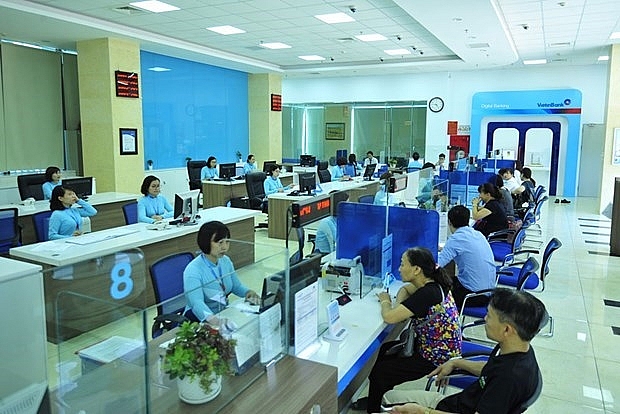Bad debts tend to rise despite slow credit expansion
 |
| A transaction office of VietinBank (Photo: VietinBank) |
Hanoi - Non-performing loans are still increasing despite slow credit expansion as the COVID-19 pandemic stretches many businesses to their limits.
The first-half financial statements of big banks like Vietcombank, BIDV and Vietinbank all indicated an increase in non-performing loans (NPLs).
Total NPLs of Vietcombank increased 11 percent in the last six months, pushing the bad debt ratio up to 0.83 percent from 0.79 percent, of which subprime loans jumped 58 percent and doubtful debts climbed 56 percent.
Ending June, NPLs at BIDV grew 17 percent over the beginning of the year, of which subprime and doubtful loans increased by 11 percent and 21 percent, respectively. The lender’s bad debt ratio increased from 1.75 percent to 2 percent.
The ratio of bad debt to outstanding loans at Vietinbank rose from 1.16 percent to 1.7 percent after NPLs jumped 48 percent in the first half. Subprime and doubtful debts climbed 250 percent and 84 percent, respectively.
This trend could also be seen in smaller banks.
Sacombank’s bad debt ratio increased from 1.94 percent to 2.15 percent by the end of June. This ratio was 1.93 percent in Orient Commercial Joint Stock Bank (OCB), up from 1.84 percent at the beginning of this year.
Asia Commercial Bank’s bad debt ratio was up from 0.54 percent to 0.68 percent after NPLs climbed 32 percent to 1.9 trillion VND (82.3 million USD), excluding debts worth 2.08 trillion VND at ACB Securities.
Bad debts at Eximbank increased 12 percent to 2.16 trillion VND by the end of June, lifting the bad debt ratio to 2.08 percent from 1.71 percent.
The COVID-19 pandemic had negatively affected business activities, leading to an increase in NPLs at many banks, even though banks have rescheduled debts for customers affected by the pandemic until the end of September 2020 under the direction of the State Bank of Vietnam (SBV).
According to Tran Du Lich, a member of the National Advisory Council on Financial and Monetary Policies, rising bad debts at banks is inevitable but are still under control.
In fact, the central bank has warned bad debt of the whole industry will likely increase to 3-4 percent this year, which is still kept in check, with banks quickly setting up risk provisions.
In the first six months, Sacombank’s provision for credit losses increased by 50 percent to nearly 1.57 trillion VND. Eximbank also set aside more than 220 billion VND for a loan loss reserve fund which lowered its pre-tax profit by 28 percent to 552 billion VND.
Increases in subprime and doubtful debts also compelled OCB and Vietcombank to increase its loan loss provisions by 49 percent and 21 percent, respectively.
Credit to rise slowly in H2
A recent report of SBV showed demand for credit was very weak in the recent past, especially in April and May when the country was affected by the lockdown due to the pandemic.
Credit increased by just 0.12 percent in April and 0.53 percent in May and improved by 1.28 percent in June. By mid-July, credit expansion reached a seven-year low at around 4 percent.
In its July report, Bao Viet Securities (BVSC) said liquidity of the banking system is still abundant, reflected in very low interbank interest rates (0.15-0.3 percent per annum for overnight, 1-week and 2-week terms).
BVSC expects credit to improve in the second half albeit slowly amid the complex developments of the pandemic in the country, making enterprises more vigilant on business prospects and production expansion plans.
Credit growth for the whole year is forecast at around 10 percent.
Meanwhile, a survey on business trends in the third quarter of 2020 of credit institutions, conducted by the SBV’s Monetary Forecasting and Statistics Department, showed credit institutions have lowered their forecasts on outstanding loan growth in two consecutive survey periods.
The outstanding credit of the banking system is predicted to grow by 3.5 percent in the third quarter and 10.5 percent in 2020, considerably lower than the expectation of 13.1-14.1 percent, respectively recorded in the two previous surveys.
The pressure to set money for loan losses reserve fund is expected to greatly affect the income and pre-tax profit of banks in 2020.
Finance-banking expert Can Van Luc also predicted although credit demand will recover in the last half, credit growth for the whole year will not be too high at around 9-10 percent.
What the stars mean:
★ Poor ★ ★ Promising ★★★ Good ★★★★ Very good ★★★★★ Exceptional
Related Contents
Latest News
More News
- Double-digit GDP growth within reach with shift to higher-value expansion (January 06, 2026 | 08:33)
- Takeda Vietnam awarded for ongoing support of Vietnam’s sustainability efforts (December 31, 2025 | 21:00)
- Vietnam's retail market tops $269 billion in 2025 amid e-commerce boom (December 31, 2025 | 19:00)
- Stronger legal framework urged as trade fraud surges online (December 31, 2025 | 18:58)
- FPT exports first chip shipment to Japan (December 31, 2025 | 10:47)
- AkzoNobel rolls out sustainability campaign “It All Adds Up” for the wood sector (December 31, 2025 | 09:23)
- Textile apparel firms deliver robust earnings despite global tariff pressures (December 30, 2025 | 10:09)
- Businesses ramp up production as year-end orders surge (December 30, 2025 | 10:05)
- Vietjet chairwoman awarded Labour Hero title (December 29, 2025 | 13:06)
- How to unlock ESG value through green innovation (December 29, 2025 | 10:03)

 Tag:
Tag:



















 Mobile Version
Mobile Version